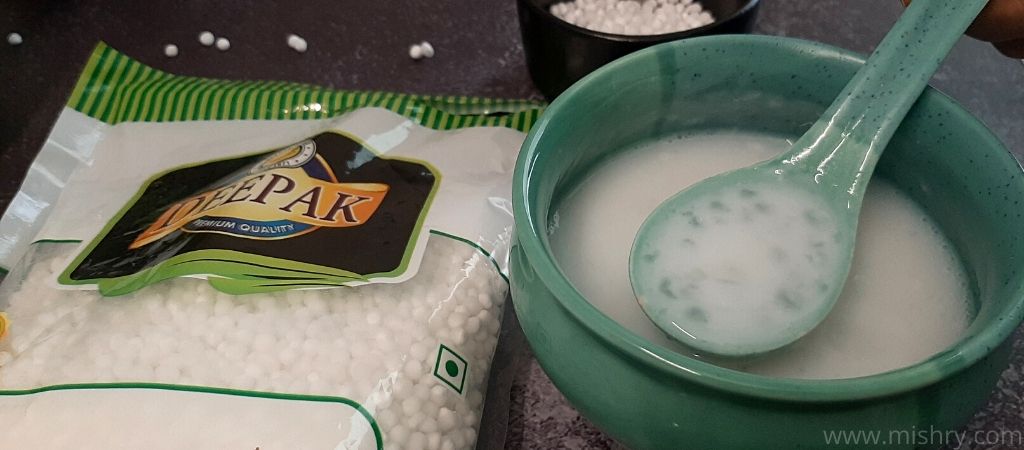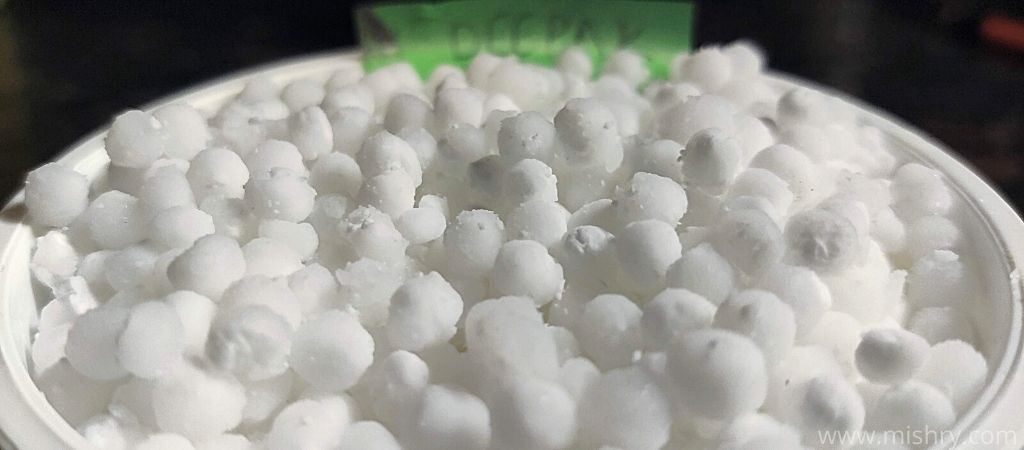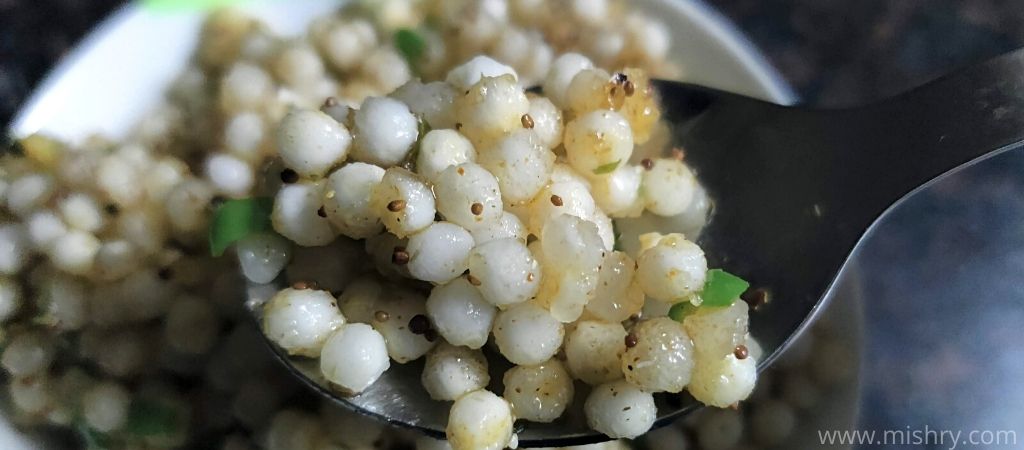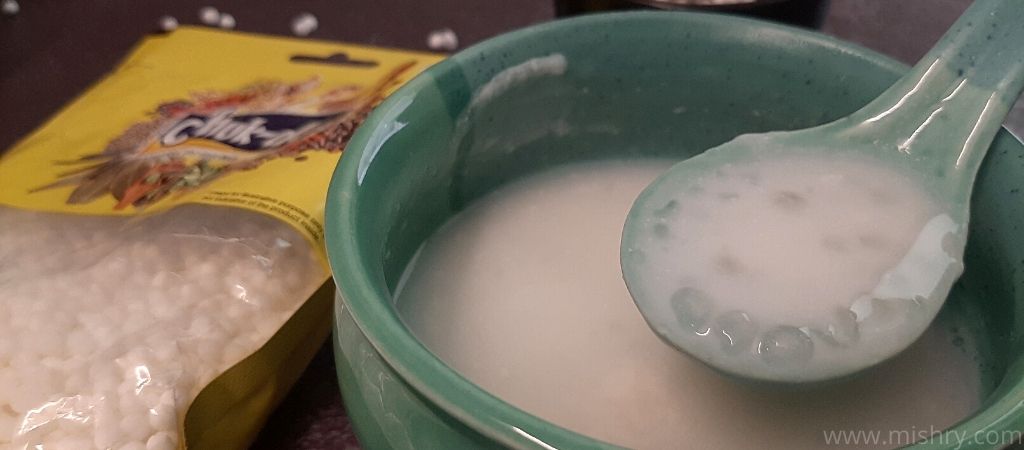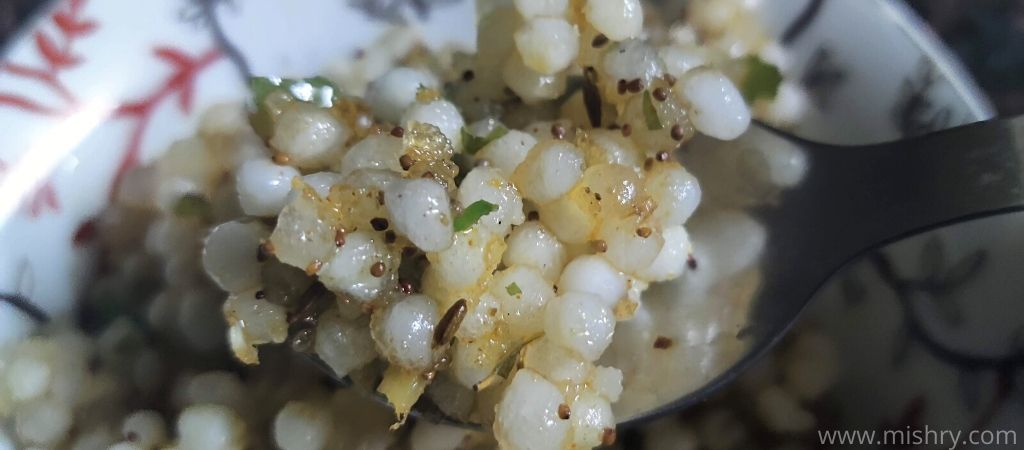This is an updated story. For this review we tested the sabudana brands using two extensively made recipes throughout India – kheer and khichdi. Our first testing (sabudana kheer) and the second testing (khichdi) resulted in a different winner, which is why this story is being updated.
We picked and tested four sabudana brands in our test kitchen for their plumpness, taste and the texture they lend to a bowl of sabudana kheer. We made kheer using all the four sabudana brands and a taste test later we chose the Sabudana by VRD Masale as the best sabudana brand (Top Pick).
We later tested the same brands with a standardised recipe of sabudana khichdi. During that testing phase we chose Deepak Sabudana (Top Pick) and Anivarya Sabudana (Recommended) as our winners. The khichdi made using both these brands were plump, non-sticky and all the pearls were separated from each other.
Why did we choose them as the best sabudana brands in India? More details ahead.
What is Navratri? Navratri is a Hindu festival celebrated in India where Indian goddesses are worshipped for a period of 9 days. A large section of the population observes fasts or dietary restrictions during these days. Fast-friendly ingredients include kuttu ka atta (buckwheat), samak ke chaawal (barnyard millet), kaddu (pumpkin), paneer (cottage cheese), singhare ka atta (water chestnut flour), sabudana (tapioca), and of course aloo (potatoes).
Related Reading:
This Navratri stock up your kitchen with these popular Navratri special snacks.
Table of Contents
Sabudana Brands in India – Everything You Need To Know
In this section we will discuss the main ingredients used to make sabudana, their nutrition facts, calories in sabudana, available brands, sizes and the multiple recipe options. Here is all about the sabudana brands in India.
Main Ingredient
A lot of confusion surrounds the difference between sago seeds and tapioca pearls. So let’s put it out there. Sago seeds and Tapioca pearls are not different visually or texture wise. The main difference lies in the core ingredient used to make these.
Sabudana/sago/tapioca can be made using any of the three sources – Palm Sago, Cycad sago and Cassava roots. Sago seeds are made from the pith or stem of the sago palm tree while tapioca pearls are made using the cassava root. Cassava root is peeled, washed, pulped, and processed to make the signature round sabudana or tapioca pearls.
In India, cassava roots are the primary source of extracting sabudana.
Nutritional Facts – Sabudana Calories
Now let’s talk about the calories in sabudana. Sabudana is essentially starch which means that it is full of carbohydrates and high in calories. As per the USDA, one cup sabudana has 544 calories.
Sabudana is considered a high calorie, high carb meal. If you’re someone trying to lose some weight, eating sabudana might not be an ideal choice. But if you’re on a gluten free diet, then you’ll be glad to know that sabudana is naturally gluten free.
Available Sizes
Sabudana is available in various sizes ranging from 200 grams, 500 grams and 1 kilogram. Choose the pack size depending on the size of family and consumption rate.
Numerous Recipe Options
The sabudana benefits are numerous, making it a versatile ingredient and can be used to make the following recipes –
- Sabudana vada
- Sabudana kheer
- Sabudana aloo tikki
- Sabudana papad
- Sabudana thalipeeth
- Sabudana khichdi
- Popped sabudana namkeen
Price Range
A 500-gram pack of sabudana can be priced anywhere between Rs 40/- to Rs 50/- depending on the brand and area of purchase.
Quick Comparison of Sabudana Brands
Here is a comparison table of the sabudana brands in India review.
| Sabudana Brands | Buy Now |
| Deepak | Add To Cart |
| VRD Masale | – |
| Anivarya | – |
| ChukDe | Add To Cart |
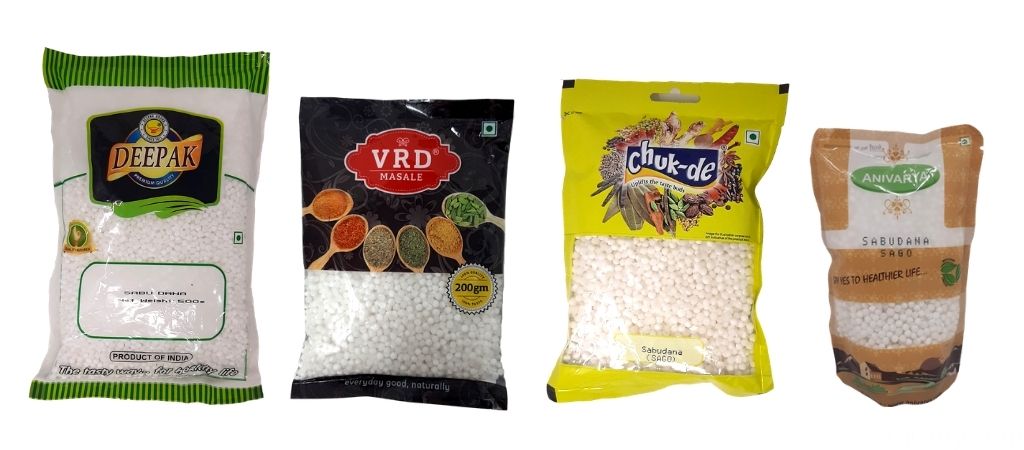
Our Review Factors
To find out the best sabudana brands in India, we set three broad parameters. Through these parameters, we got a clear picture about the quality and texture of the sabudana brands. For this review, taste was not the governing factor. Sabudana does not have a distinct taste of its own, but it does have a characteristic texture that can make or break a dish.
Here is how we reviewed these sabudana brands!
1. Texture
When we say texture, we mean the starchy chewiness of the sabudana. Sabudana/Tapioca, by nature, is supposed to have that little sticky-chewiness which should reflect well in any dish.
2. Quality of Sago Seeds/ Tapioca Pearls
Sabudana needs to be soaked for a couple of hours or overnight before they are used to create a dish. After soaking we noticed the following – How well does the sabudana plump up? Has it become partially opaque after soaking or is it still hard?
While soaking, does the sabudana dissolve in the water or does it retain its form? We also noticed if the tapioca pearls became soggy and lumpy after soaking.
3. Price
Are the sabudana prices competitive or too high?
Who Is This Review For?
Sabudana can be used to make multiple dishes. If you’re someone who loves cooking with sabudana, fasting or not, this review is for you. Our review of the best sabudana brand will help you choose better.
The Brands We Picked
We picked four sabudana brands from an online grocery shopping portal –
- Deepak Sabudana
- ChukDe Sabudana
- VRD Masale Sabudana
- Anivarya Sabudana
Our Review Process (Kheer)
For our review, we divided the testing into two phases.
Phase 1 included soaking the tapioca pearls in water. The soaking time varied from brand to brand. After soaking, we noted down the plumpness, size of the pearl, and dissolving properties of the sabudana (if any).
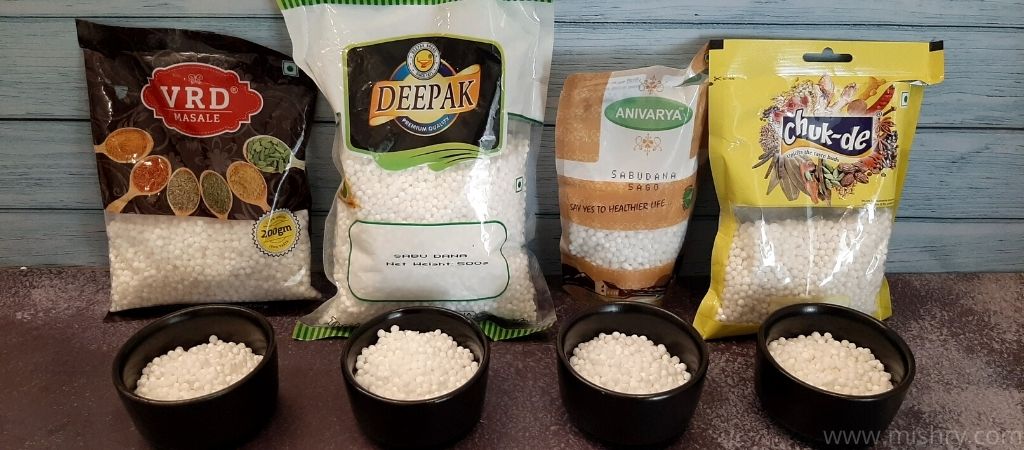
Phase 2 (Mishry Secret Sauce) – In this stage we cooked the sabudana using the simplest recipe. While sabudana is also used to make a khichdi or a vada at home, we tested the sabudana brands by using them to make a creamy milk-based kheer.
We did not add any aromatics like saffron or cardamom to the kheer. Any nuts and currants were also not added to keep the kheer recipe as basic as possible as we wanted the cooking of the sabudana to be highlighted.
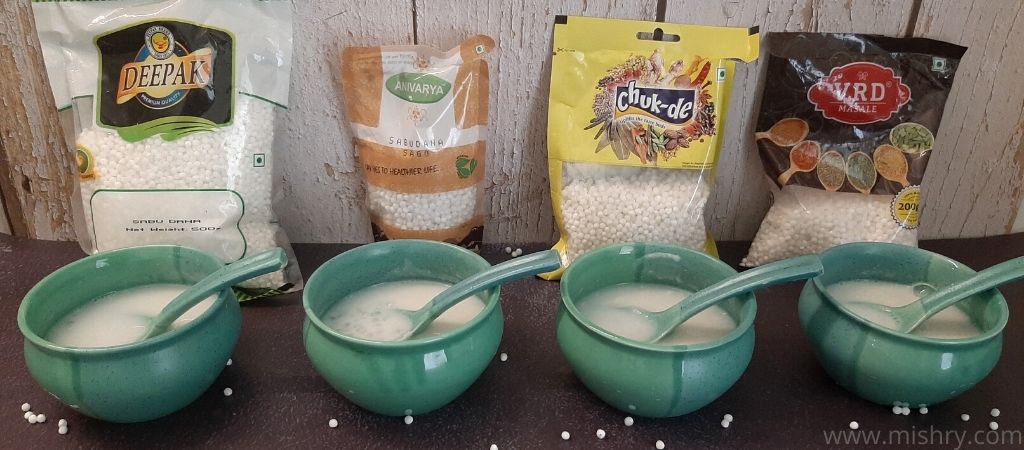
The measurements were standardised. We followed a basic recipe using 1/8th cup of milk, 10 grams sugar and 2 Tbsp soaked sabudana for all the brands. After cooking them on a medium-low heat setting on our Amazon Induction Cooktop, we transferred them in bowls and let them sit. Post that, we tasted the kheer lukewarm, side by side.
Our Review Process For Testing The Sabudana (Khichdi)
Sabudana kheer and sabudana khichdi are both equally popular and made extensively during fasting. Which is why in addition to the kheer, we decided to test the brands in the form of a khichdi as well.
During phase 1 we soaked the sabudana pearls overnight in water. The water to sabudana ratio was exactly the same. Once they plumped up, we checked them for their plumpness and to see if they have retained a ‘bite’ or they dissolved completely.
For phase 2 of the sabudana testing we used a standardised recipe that was followed for all the brands. From the ghee, peanuts and aromatics to the masala-mix, everything was measured out exactly the same.
Once the sabudana khichdi was ready, we checked them for their texture.
Related Reading:
Try these top 4 different variety of tasty dishes made with sabudana this Navratri.
Best Sabudana Brands in India – Detailed Review
1. Deepak Sabudana
A 500-gram pack of Deepak Sabudana is priced at Rs 100/-. Sabudana by Deepak took 1 hour 50 minutes to soak. Just like ChukDe Sabudana, some pearls dissolved completely and some required some more soaking.
During our cooking process we noticed that the pearls plumped up nicely and turned translucent. While these weren’t mushy, the sabudana was on the verge of dissolving in the kheer. The sabudana kheer was not lumpy at all.
Khichdi testing – The khichdi made using Deepak’s Sabudana was wonderfully plump and non-sticky. The khichdi was khili-khili and retained their bite. The pearls weren’t chalky or too mushy, the texture was just right, which is why we chose this brand as our Top Pick for sabudana khichdi.
- The texture of the kheer is not mushy.
- The tapioca pearls plumped up well and turned translucent upon cooking.
- This brand of sabudana is well-suited for making a khichdi as all the pearls are separated and not lumpy.
- The sabudana has a very low ‘bite’.
- The pearls did not soak uniformly (kheer).
2. V R D Masale Sabudana
A 200-gram pack of VRD Masale Sabudana is priced at Rs 50/-. This sabudana brand took the longest time to soak properly. After 3.5 hours of soaking, the sabudana pearls swelled up uniformly.
The size of the pearls is comparatively larger than the other contenders. This property of the sabudana makes it an ideal brand that can be used to make khichdi as well as kheer.
While cooking the kheer, there was no lumpiness and the kheer came out rich and creamy. The bite of the sabudana remained intact.
Khichdi testing – The khichdi made using VRD’s sabudana was non-sticky, and the pearls plumped up well. While there is nothing wrong with the khichdi we made with VRD’s sabudana, the texture was a step down in comparison to Deepak and Anivarya.
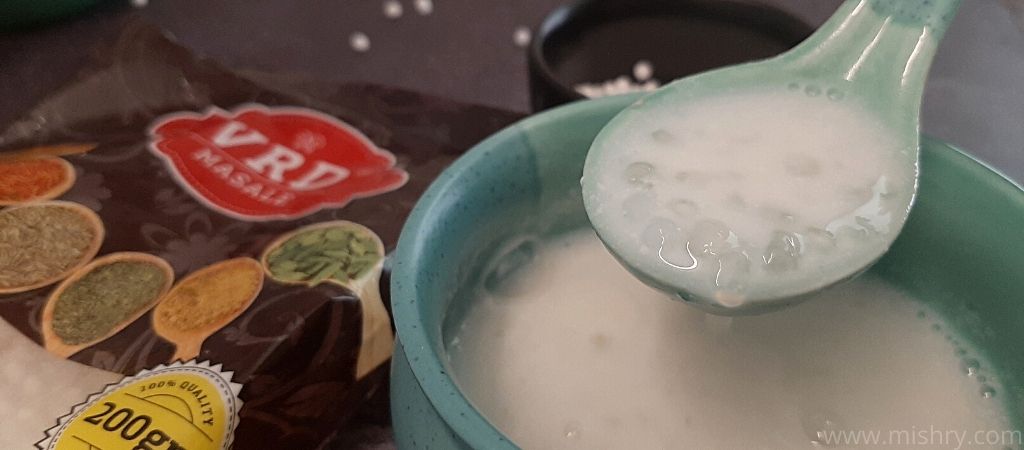
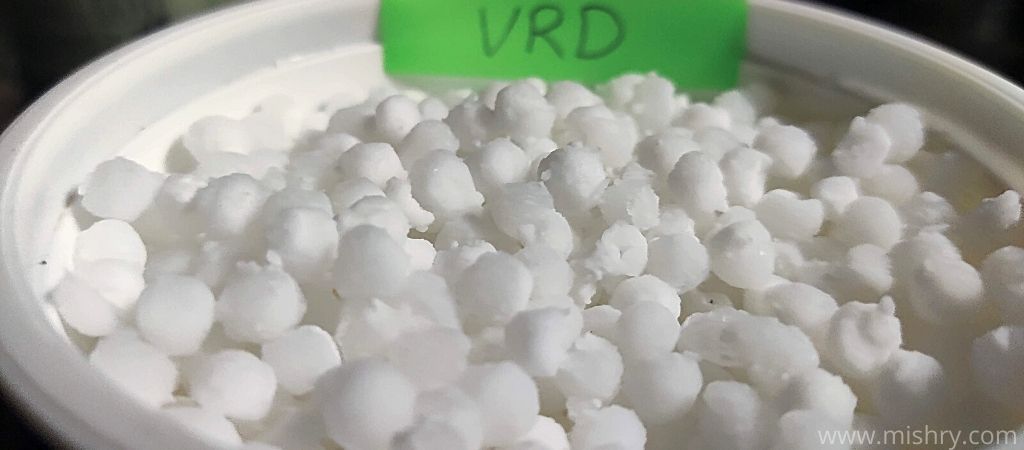
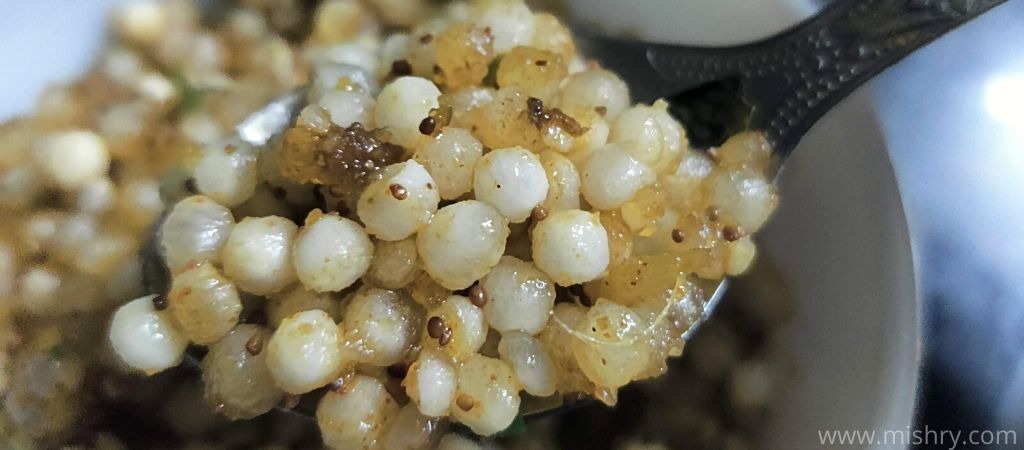
- The sabudana soaked uniformly.
- The kheer did not become mushy or lumpy after cooking.
- There is a certain chewy, sticky bite in the sabudana.
- These did not dissolve upon soaking.
- If you’re looking for a brand that makes good quality kheer and decent sabudana khichdi, VRD is the brand for you.
- The VRD Masale Sabudana has a larger pearl size which makes it suitable for various recipes including a sabudana khichdi, thalipeeth and kheer. People who cook with sabudana often can use this for multiple recipes.
3. Anivarya Sabudana (Sago)
A 200 gram pack of Anivarya Sabudana is priced at Rs 39/-. This brand of sabudana took the least amount of time to soak uniformly. Within 1 hour 30 minutes, the sabudana was uniformly plumped up.
We noticed that during our cooking process, most of the gloubles or pearls of tapioca started to dissolve or were too broken. This is why this won’t be recommended to make a khichdi. Even though the kheer made using this brand of sabudana was not lumpy, but the sabudana ‘bite’ was completely missing.
Khichdi testing -The pearls of Anivarya’s Sabudana khichdi were beautifully plump and absolutely non-sticky. We loved how each pearl was completely separate. Anivarya is a good brand of sabudana if you’re looking to make a khichdi out of it.
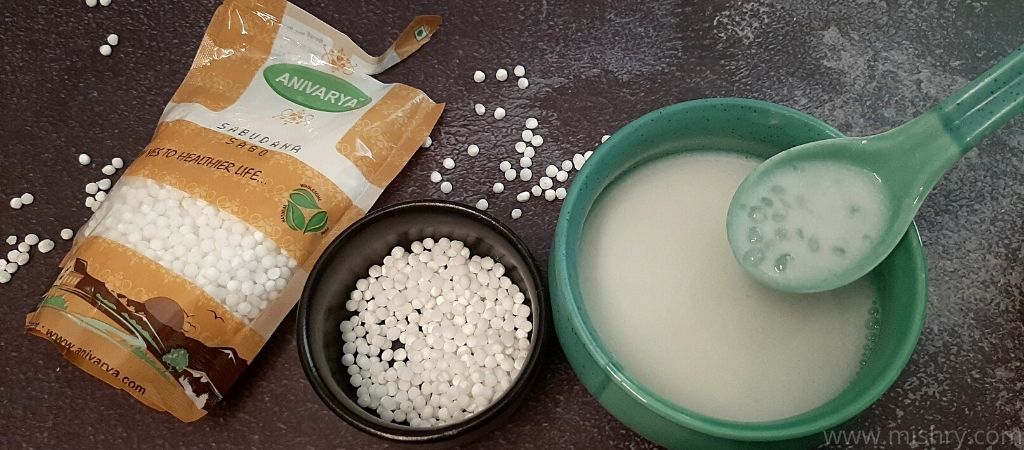
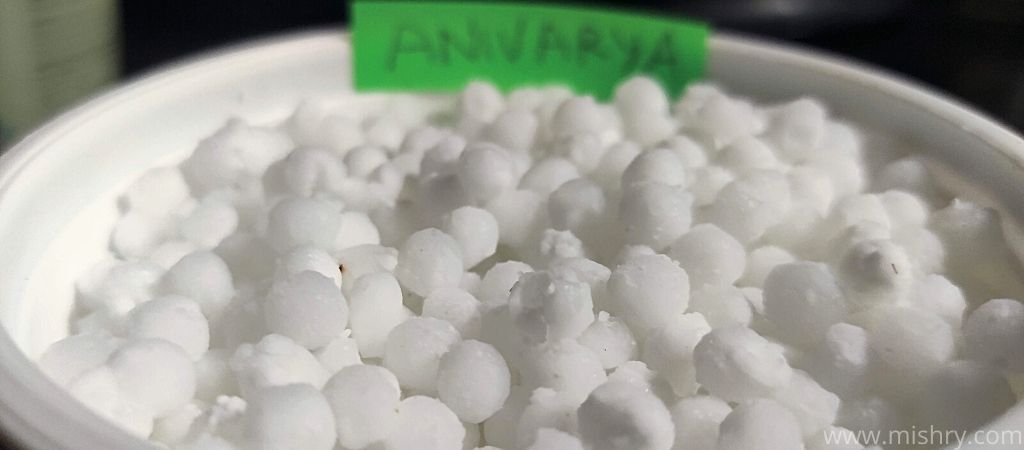
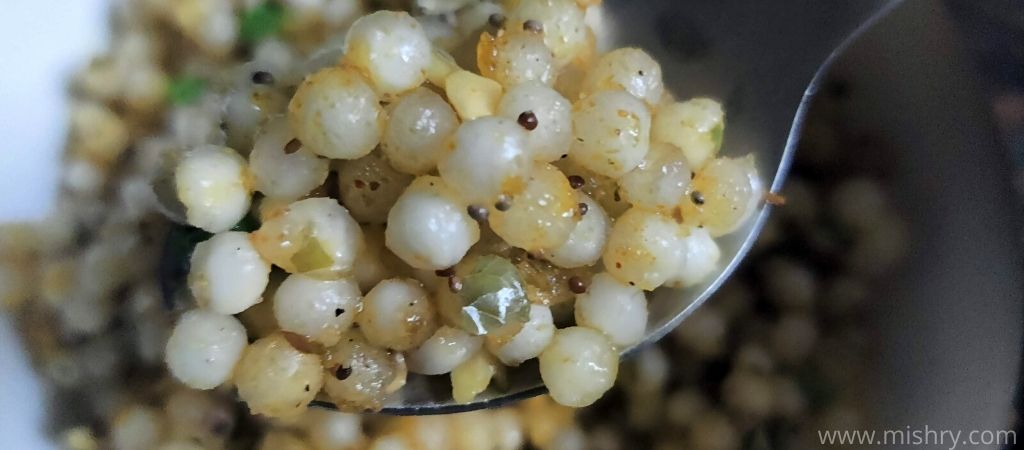
- Soaked the quickest.
- The pearls plumped up uniformly after soaking.
- We liked the khili-khili khichdi made using the Anivarya Sabudana.
- The sabudana pearls were either too broken or were dissolving at a very fast rate (kheer).
- The tapioca pearls lack the signature bite when tested for kheer.
4. Chukde Spices Sabudana/Sago Seeds
A 200 gram pack of Chukde Spices Sabudana is priced at Rs 45/-. The sabudana was washed under running water and then soaked them in room temperature water.
Sabudana by Chukde Spices took 2 hours to soak properly. We noticed that while some pearls had dissolved completely, some still required more soaking. This may not be the best for making a sabudana khichdi as there is no uniformity.
The kheer made using this sabudana brand was lumpy. Throughout the kheer we could only see very few plumped up pearls of sabudana as most of them had already dissolved.
Khichdi testing – Coming to the khichdi made using Chukde Sabudana. Post soaking these pearls, we noticed that quite a lot of them had started to disintegrate. Not only that, the pearls were very sticky and in places they became a little lumpy.
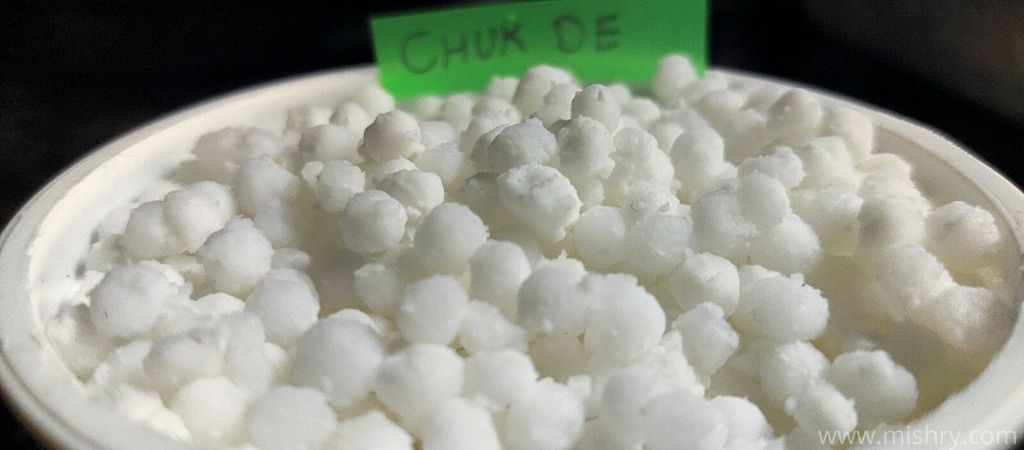
- There is no uniformity in soaking. After a 2 hour soaking time, some pearls had dissolved, while the others needed more soaking.
- The kheer made using this brand of sabudana was lumpy.
- Lacks the ‘bite’ you expect out of sabudana.
- The khichdi made using the Chukde Sabudana was lumpy and sticky.
Our Top Picks & Recommendations
Why did we choose VRD Masale Sabudana as our Top Pick (Kheer)?
A sabudana kheer needs to have that thick, creamy consistency that comes from the starchy tapioca and slow cooked milk. The sabudana pearls in the kheer, ideally, should have a chewy, bouncy-starchy bite.
We chose VRD Masale Sabudana as our Top Pick because it soaked uniformly and did not dissolve in the water. Not only that, the size of the tapioca pearl is also the largest amongst the contenders. This cooked well in a kheer and did not lose their signature bite.
Why did we choose Deepak Sabudana as our Top Pick (Khichdi)?
A good sabudana khichdi has two main attributes – it should not be sticky and the bite of the sabudana should be maintained. The ‘khili-khili’ khichdi is what we all look for.
The plump pearls and non-sticky khichdi is what made us choose Deepak Sabudana as our Top Pick. After soaking all the sabudana brands overnight in the same amount of water, we noticed that the pearls of Deepak Sabudana plumped up well and did not dissolve in water or lose their shape. After cooking, the pearls were separated and had the characteristic sabudana bite.
Why do we Also Recommend Anivarya Sabudana (Khichdi)?
Just like our Top Pick, Anivarya’s sabudana pearls plumped up well after overnight soaking and did not dissolve or lose their standard round shape. The pearls were separated from each other and did not become a lumpy mass post cooking. The starchy bite of sabudana remained intact.
Frequently Asked Questions
Here are some interesting FAQs on sabudana brands.
1. Which sabudana is best?
As per our review, VRD Masale Sabudana was the best sabudana brand. Not only does it plump up well, it also has the signature bouncy-starchy bite.
2. How to store sabudana?
Sabudana should be stored in an airtight container after the pouch is open. It doesn’t require any refrigeration.
3. Where do we get sabudana from?
Sabudana is also known as sago or tapioca is a plant based starch that can be extracted from three plants – sago palm, roots of cassava plant and cycad palm. Due to toxicity, sago is rarely extracted from the cycad plant. The main source of sago in India is the cassava root. The roots of the cassava plant are washed, peeled, mashed and then processed to turn them into tapioca pearls.
4. Which sabudana should you use for khichdi and kheer?
To make sabudana khichdi or vadas, bigger sabudana pearls are preferred as they enhance the overall consumption experience. For kheers and payasams and puddings, smaller pearls are preferred. That being said, they should have a bite factor and not become lumpy.
5. What is the difference between big and small sabudana?
Tapioca, medium-sized pearls, are derived from the cassava root. Kheer, tikki and other sweet/savory dishes can be prepared with this.
Sago, smaller pearls, are derived from the starch of the metroxylon tree. This is staple of the south east Asian regions.
The aroma and appearance are fairly similar.
Final Words
Sabudana kheer made using VRD Masale Sabudana has the best texture. Which is why it was chosen as our Top Pick. The other three contenders of sabudana brands produced unimpressive bowls of kheer.
While testing the brands for Sabudana Khichdi, we chose Deepak Sabudana as our Top Pick because the pearls plumped up the most and produced a non-lumpy khichdi. We Also Recommend Anivarya Sabudana to make khichdis.
How do you enjoy your sabudana? In a kheer, a khichdi, tikki or as a thalipeeth? Let us know in the comment section below.
Our reviews are unbiased and all samples used during the reviews were paid for by us. Read our entire ethics statement here.


